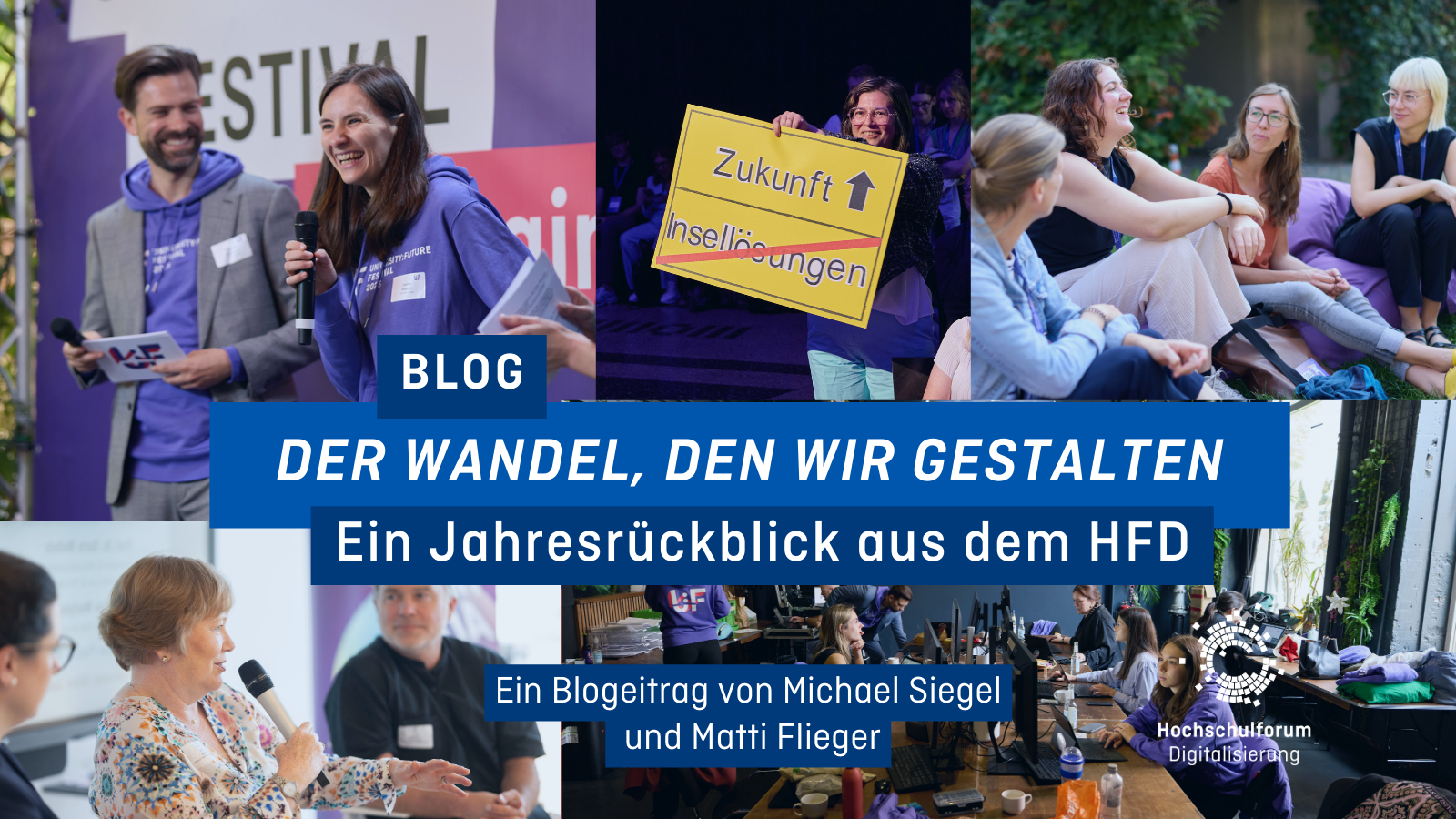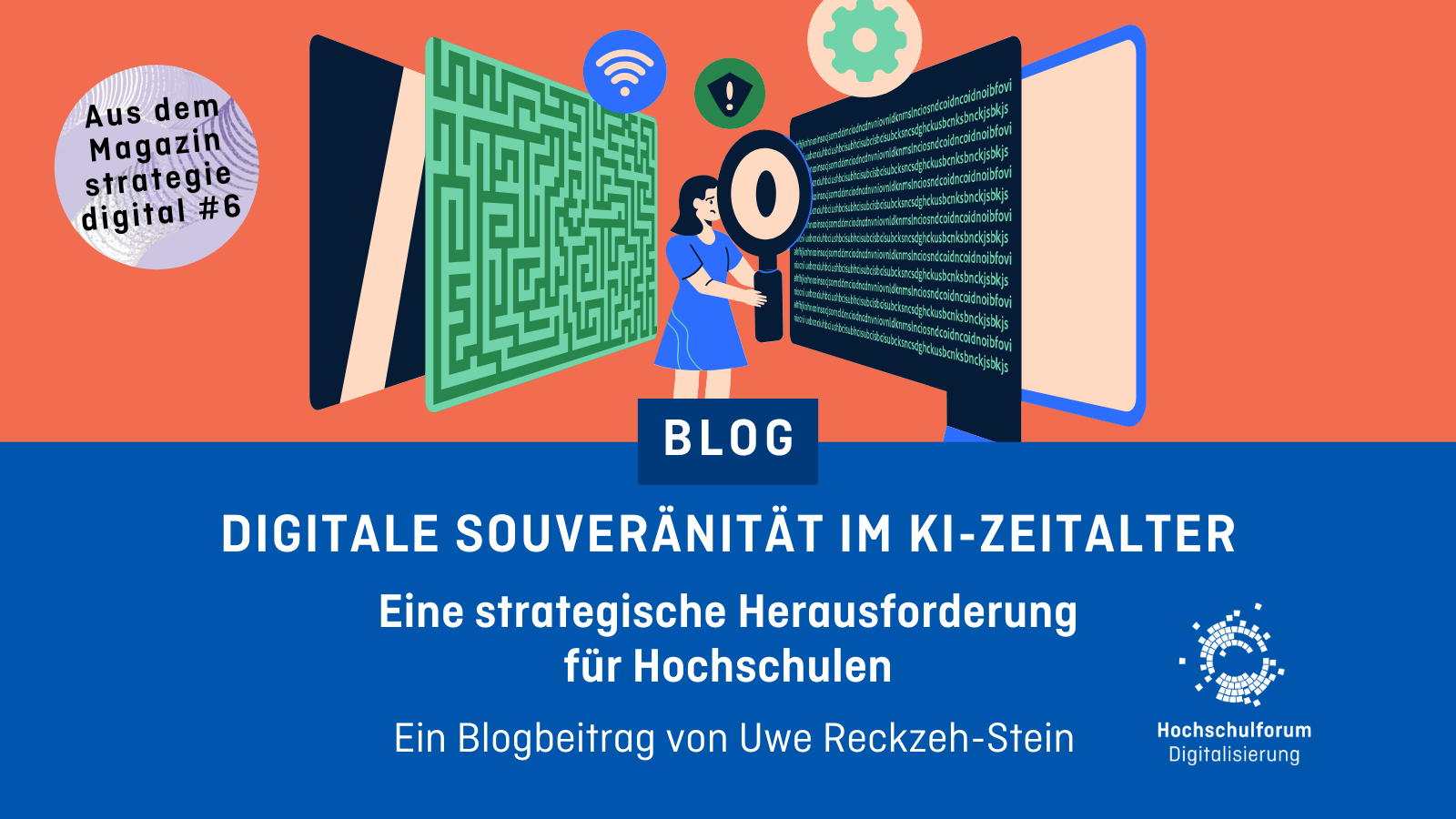The Slinking Process of Digitisation of Higher Education Institutions
The Slinking Process of Digitisation of Higher Education Institutions
05.12.19
“Without the universities themselves having noticed it, they have become data- and software-driven institutions. This means that in many areas they use complex software systems in which data is generated on a large scale without these data (apart from research) being subjected to an evaluation.” Dr Hubertus Neuhausen, Director of the University and City Library Cologne and member of the ad-hoc AG “Higher Education for the Digital Age in the European Context”, explains his view on the influence of gradual digitisation on processes at universities.
This article was automatically translated using DeepL Translator. Please excuse any errors.
1) Digitisation and universities
If you look at complex organisations such as universities, there are a multitude of perspectives on how they can be viewed meaningfully and profitably. The term digitisation is used in this article primarily in connection with processes. When talking about the digitisation of universities, it means that the essential processes of a university such as teaching and research as well as the operation of an extensive infrastructure are increasingly carried out with the help of software, data and the necessary hardware. The complexity of these software systems continues to increase. At first, this sounds very trivial, almost banal, but this development has a considerable changing effect both in our daily lives and in the everyday life of universities.
We usually do not notice these changes. They happen successively and creep into daily habits. The economist Richard Baldwin calls this process the “iPhone infiltration”: “Over the years, the iPhone has gradually expanded its range of services. We have integrated these services bit by bit into our everyday lives, such as the online calendar, the mail function, the text messages, the podcast and music app, etc., because they are very convenient and useful. Many people now feel helpless without their smartphone. Our behavior has changed considerably over the years without us perceiving this process as such (Baldwin, 2019 pp. 196-197). The thesis of this article is that it happened – mutatis mutandis – in the same way in the universities.![Picture: [https://unsplash.com/photos/ewGMqs2tmJI Nathan Dumlao] Digitization at universities - Symbol image](/sites/default/files/images/blog/nathan-dumlao-ewGMqs2tmJI-unsplash.jpg)
In a university there are usually three different “business areas” that follow different “logics”:
- Academic teaching or training can – very simply – be understood as a “process business”: Former students* go through a clearly structured course of courses and leave the university as freshly graduated academics*.
- Scientific research can – also very simply – be understood as a “solution shop”: A concrete scientific question or problem is examined until a solution is found.
- Substantial infrastructures are necessary for universities to be able to provide teaching and research at all: They need administrations and own real estate. They operate libraries, computer centres and facilities such as university sports. A whole series of sub-organisations and a large number of employees* are necessary for the university to function at all. This could be called a “facilitated network” – analogous to a fitness studio whose equipment can be used for a monthly fee.
As a result of an almost 200-year-old habituation, we no longer perceive these three areas separately in a college (Christensen, 2012 min. 69-72). They interact to a large extent with each other and are mutually dependent.
2) Universities as “software landscapes”
Each of these three business areas digitizes in a very different way:
- In research, software and data are increasingly becoming the results of research efforts alongside the classic media of books and magazines. Big data analyses and simulations are becoming legitimate research methods. Software-based large-scale devices that produce data on a large scale, e.g. in the field of gene sequencing, are changing the research landscape. Even the humanities are taking energetic steps in this direction with the Digital Humanities (Expert Commission on Research and Innovation, 2019 p. 95-6; German Research Foundation, 2018 p. 12-14; Gilch u. a., 2019 p. 43-46; RfII – Council for Information Infrastructures, 2016 pp. 9-18).
- In so far as academic teaching implies research-based learning, digital instruments and methods penetrate university teaching. In addition to the classical teaching formats of lecture and seminar, new digital forms such as the inverted classroom (Gilch and others) are emerging, 2019 p. 49-54; Handke, 2014; Nacken, 2017).
![Picture: [https://unsplash.com/photos/466ENaLuhLY Markus Spiske] Universities as software landscape - symbol image](/sites/default/files/images/blog/markus-spiske-466ENaLuhLY-unsplash.jpg)
- A large part of the infrastructure is now provided with the help of software systems such as research information systems (FIS) in the area of research management, campus management systems and e-learning platforms in the area of teaching and studies, comprehensive administration software such as SAP in the area of administration (Thillosen, 2017 min. 19-24).
This process (also) turns universities into technical ecosystems (Hechler & Pasternack, 2017). In spite of its overturning character, the overall process of digitisation as such is very rarely considered and reflected upon by universities. A real discussion only takes place on the subject of digital teaching. Without the universities themselves having perceived it, they have become data- and software-driven institutions. This means that in many areas they use complex software systems in which data is generated on a large scale without these data (apart from research) being evaluated.
As a rule, these software tools have been introduced through stakeholder initiatives to meet a concrete need, or project funding is available that can be used for a concrete occasion. In most cases, these initiatives were not embedded in an overarching strategy. This resulted in many universities in a software landscape consisting of “silos” , which are usually only superficially linked. This means that there is a complex ecosystem of software that is, however, little integrated (Expert Commission on Research and Innovation, 2019 pp. 101-102; Hechler & Pasternack, 2017 p. 10-14).
3) University as a specific type of organisation and its effects on the different digitisation speeds in the three “business areas”
All universities try to become like the few internationally outstanding top universities (Harvard and Stanford, Oxford and Cambridge, ETH Zurich). Without making it explicit, the universities in Germany behave in the same way, not least in the competition for excellence (Heine, 2019; Wiarda, 2016). The ideal image is that of a research-oriented university with a high level of third-party funding, which trains its students close to research and, if possible, as active academics* itself (doctorate, habilitation). The research university is the guiding star for the higher education system, which the entire system orients itself towards in a competition for the greater and better, e.g. when the universities of applied sciences seek the right to award doctorates (Christensen & Eyring, 2011 p. XIX-XXX and 3-30; Willets, 2017 p. 3-4, 36-39).
![Picture: [https://unsplash.com/photos/e3Uy4k7ooYk Davide Cantelli] Universities as Organization - Symbol Image](/sites/default/files/images/blog/davide-cantelli-e3Uy4k7ooYk-unsplash.jpg) If universities are regarded as a specific type of organization, then universities have a much lower cohesion or a much lower degree of integrated structure than it appears from the outside. Clark Kerr, President of the University of California from 1958-1967, very aptly described universities as “a series of faculty entrepreneurs held together by a common grievance over parking” (quoted from Willets, 2017 p. 34). Universities can be understood as a collection of science or research entrepreneurs* (projects, chairs and institutes) who want to prove themselves optimally and be successful in the great competition for career opportunities, financial resources and prestige that science is (Schimank, 2005 p. 148-149).
If universities are regarded as a specific type of organization, then universities have a much lower cohesion or a much lower degree of integrated structure than it appears from the outside. Clark Kerr, President of the University of California from 1958-1967, very aptly described universities as “a series of faculty entrepreneurs held together by a common grievance over parking” (quoted from Willets, 2017 p. 34). Universities can be understood as a collection of science or research entrepreneurs* (projects, chairs and institutes) who want to prove themselves optimally and be successful in the great competition for career opportunities, financial resources and prestige that science is (Schimank, 2005 p. 148-149).
This results in a number of consequences that are also very relevant for the different dynamics and speeds in the digitisation of higher education institutions:
- The members of the university management were or are successful science entrepreneurs themselves, and they are elected by science entrepreneurs (Roessler, 2019; Symanski, 2012; Wiarda, 2019a). The decisions of the university management are mainly made from this perspective: Research, especially cutting-edge research, has the highest priority in the priority structure of a university.
- In all areas concerning their research, science entrepreneurs* are highly agile and integrate disruptive developments such as those resulting from digitisation with the greatest willingness. As a result, research is digitizing at a very high speed: for example, the efforts within the framework of the National Research Data Infrastructure (NFDI) or the Medical Informatics Initiative are mentioned here (Expert Commission on Research and Innovation, 2019 pp. 95-96; German Research Association, 2018 pp. 12-14; Gilch et al., 2019 pp. 43-46).
- Since the same science entrepreneurs* not only have to do research, but also teach and manage the university within the framework of self-administration, they permanently live in a state of structural overload. Therefore, questions of teaching, infrastructure and their digitisation have a significantly lower priority and there is not the same agility in these areas as in research. In order to deal economically with their own forces, scientists* are often structurally conservative in the areas of teaching and infrastructure (Expert Commission on Research and Innovation, 2019 pp. 97-98; Gilch u. a., 2019 pp. 46-55; Persicke & Friedrich, 2016 p. 35-38).
4) Governance
In surveys, university managers attach great importance to the subject of digitisation, but a more intensive examination of these questions only began in recent years (Expert Commission on Research and Innovation, 2019 pp. 92-94; Gilch et al., 2019 pp. 41-42, 63-64, 98-100; Persicke & Friedrich, 2016 pp. 38; Schmid, Lutz, Radomski, & Behrens, 2017 p. 23-30). Even though Chief Information Officers have increasingly been appointed at universities in recent years, university management often lacks a “digital” perspective, i.e. an awareness that digitisation makes profound changes necessary in all areas of universities.
To put it in a nutshell, one can say that the digitization of universities is not just a technical project, i.e. the introduction of technical systems. It also requires a considerable cultural change and far-reaching organisational development in the university system as a whole. A study has shown that at least three “digital savvy board members” are required in commercial enterprises in order to create a sustainable digital perspective on the board of a company that focuses on the entire company (Weill, Apel, Woerner, & Banner, 2019). It should not be diminished at this point, which has so far also been achieved by the university management in the field of digitisation at many locations. However, if one considers how the lines of university management are usually recruited, a “digital savvy” rectorate or presidium is more likely to be the exception (Rienhoff, 2017 Min. 24.26-25.55; Roessler, 2019; Wiarda, 2019a, 2019b).![Image: [https://unsplash.com/photos/eMP4sYPJ9x0 Sharon McCutcheon] Knowledge Management - Symbol Image](/sites/default/files/images/blog/sharon-mccutcheon-eMP4sYPJ9x0-unsplash.jpg)
5) Outlook
Three “laws” of digital technology already have an enormous changing impact:
- Moore’s Law: Since 1965, the performance of a computer chip has doubled approximately every 18 months.
- Gilder’s Law: The rate at which data can be transferred is higher than the growth in the performance of processors in computers (Moore’s Law). This has not proved to be entirely true, but the almost explosive increase in transmission performance has made the enormous access rates, for example to social networks or Youtube, possible in the first place.
- Varian’s law: From time to time new technologies emerge, which provide an extensive set of components and by always new combinations of these components new products can develop. Once these components are in place, they set off a technology boom in which innovators* work their way through the possibilities.
These “laws” are still effective. This means that digitisation will continue to progress at a high speed and that a great dynamic of change will be maintained in all our daily lives, in the world of work and economic processes, and not least in universities (Baldwin, 2019 pp. 89-102; Friedman, 2016 pp. 19-117). One consequence of this is that discussions are beginning first in England, but increasingly also in Germany, about the extent to which universities are preparing their graduates* sufficiently for a digitised world of work (e.g. Meyer-Guckel, Klier, Kirchherr & Winde, 2019; University UK, 2018).
6) Literature references:
Baldwin, R. (2019). The Globotics Upheaval. Globalization, Robotics and the Future of Work. London: Weidenfeld & Nicolson.
Christensen, C. (2012). Disruption in Higher Education. In Academic Partnership. Dallas, Texas: Youtube. Abgerufen von https://www.youtube.com/watch?v=yUGn5ZdrDoU
Christensen, C., & Eyring, H. J. (2011). The Innovative University : changing the DNA of Higher Education from the inside out. San Francisco: Jossey-Bass.
Expertenkommission Forschung und Innovation. (2019). Gutachten zur Forschung, Innovation und technischer Leistungsfähigkeit Deutschlands 2019. Abgerufen von https://www.e-fi.de/fileadmin/Gutachten_2019/EFI_Gutachten_2019.pdf
Forschungsgemeinsschaft, D.-D. (2018, März 15). Förderung von Informationsinfrastrukturen für die Wissenschaft.Ein Positionspapier der Deutschen Forschungsgemeinschaft. Abgerufen von https://www.dfg.de/download/pdf/foerderung/programme/lis/positionspapier_informationsinfrastrukturen.pdf
Friedman, T. L. (2016). Thank You for Being Late. London: Penguin.
Gilch, H., Beise, A. S., Krempkow, R., Müller, M., Stratmann, F., & Wannemacher, K. (2019). Digitalisierung der Hochschulen Ergebnisse einer Schwerpunktstudie für die Expertenkommission Forschung und Innovation (Studien zum deutschen Innovationssystem No. 14–2019). Berlin. Abgerufen von https://www.e-fi.de/fileadmin/Innovationsstudien_2019/StuDIS_14_2019.pdf
Handke, J. (2014). Die Hochschullehre im 21. Jahrhundert – vom Inverted Classroom zum MOOC. In C. for T. and L. (CTL) U. Wien (Hrsg.), CTL-Lecture. Wien: Youtube. Abgerufen von https://www.youtube.com/watch?v=3lDLe0r15uc
Hechler, D., & Pasternack, P. (2017). Das elektronische Hochschulökosystem. Die Hochschule, 26(1), 7–18.
Heine, H. (2019, Juli 5). Der Regierende Bürgermeister als Wissenschaftssenator. Wie Michael Müller aus Berlin eine Forschungsmetropole macht. Die Charité an der Weltspitze, ein deutsches Harvard aus Berlin – dem erfolgsarmen Senatschef Michael Müller ein Coup gelungen. Der Tagesspiegel. Abgerufen von https://www.tagesspiegel.de/themen/reportage/der-regierende-als-wissenschaftssenator-wie-michael-mueller-aus-berlin-eine-forschungsmetropole-macht/24526292.html
Meyer-Guckel, V., Klier, J., Kirchherr, J., & Winde, M. (2019). FUTURE SKILLS: STRATEGISCHE POTENZIALE FÜR HOCHSCHULEN (Future Skills Diskussionspapier No. 3). Essen. Abgerufen von https://www.stifterverband.org/medien/future-skills-strategische-potenziale-fuer-hochschulen
Nacken, H. (2017). Blended Learning für die Web 2.0 Generation. In C. for T. and L. (CTL) U. Wien (Hrsg.), CTL-Lecture. Wien: Youtube. Abgerufen von https://www.youtube.com/watch?v=kl8PcRLDOz4
Persicke, M., & Friedrich, J.-D. (2016). Lernen mit digitalen Medien aus Studierendenperspektive (Arbeitspapiere No. 17). Berlin. https://doi.org/10.1026/0033-3042/a000301
RfII – Rat für Informationsinfrastrukturen. (2016). Empfehlungen zu Strukturen, Prozessen und Finanzierung des Forschungsdatenmanagements in Deutschland. Göttingen. Abgerufen von http://www.rfii.de/download/rfii-empfehlungen-2016/
Rienhoff, O. (2017). Empfehlungen zum Aufbau des Forschungsdatenmanagements in Deutschland. Aufzeichnung eines Vortrages auf der ZKI-Tagung im Frühjahr 2017 in Köln. In ZKI-Tagung. Köln: Zentrum für Kommunikation und Informationsverarbeitung e.V. Abgerufen von https://opencast.uni-koeln.de/paella/ui/watch.html?id=66517bf5-dbdd-4d80-a674-7e4ad0a1f2b8
Roessler, I. (2019). Check – Universitätsleitungen in Deutschland. Stand Dezember 2018. Gütersloh. Abgerufen von http://www.che.de/downloads/CHECK_Universitaetsleitung_in_Deutschland.pdf
Schimank, U. (2005). Die akademische Profession und die Universitäten. „New Public Management“ und eine drohende Entprofessionalisierung. In T. Klatetzki & V. Tacke (Hrsg.), Organisation und Profession (S. 143–165). Wiesbaden: Verlag für Sozialwissenschaften.
Schmid, U., Lutz, G., Radomski, S., & Behrens, J. (2017). Die Hochschulen im digitalen Zeitalter (Monitor Digitale Bildung No. 2). Gütersloh. https://doi.org/10.11586/2017014
Symanski, U. (2012). Uni, wie tickst Du? Eine exemplarische Erhebung von organisationskulturellen Merkmalen an Universitäten im Zeitalter der Hochschulreform. Aachen: Publikationsserver der RWTH Aachen University. Abgerufen von http://publications.rwth-aachen.de/record/197558/files/4347.pdf
Thillosen, A. (2017). Digital (Re-)Turn. 20 Jahre E-Learning an Hochschulen in Deutschland- ein perspektivisches Fazit. In GML2– Grundfragen Multimedialen Lehrens und Lernens. Berlin: Center für Digitale Systeme (CeDIS) E-Learning, E-Research, Multimedia – Freie Universität Berlin. Abgerufen von http://www.gml-2017.de/mediathek/thillosen/index.html?autostart=1.
University UK. (2018). SOLVING FUTURE SKILLS CHALLENGES. London. Abgerufen von https://www.universitiesuk.ac.uk/policy-and-analysis/reports/Documents/2018/solving-future-skills-challenges.pdf
Weill, P., Apel, T., Woerner, S. L., & Banner, J. S. (2019). It Pays to Have a Digitally Savvy Board. MIT Sloan Management Review, 60(3), 41–45. Abgerufen von https://sloanreview.mit.edu/article/it-pays-to-have-a-digitally-savvy-board/
Wiarda, J.-M. (2016, März 23). Stanford-Präsident zur Exzellenzinitiative: Wir sind das falsche Vorbild. Blog von Jan-Martin Wiarda. Abgerufen von https://www.jmwiarda.de/2016/03/23/stanford-präsident-zur-exzellenzinitiative-wir-sind-das-falsche-vorbild/
Wiarda, J.-M. (2019a, Februar 7). 59, männlich, westdeutsch. Die deutschen Universitäten wollen dynamisch sein, vielfältig, international. Eine Studie zeigt nun die Realität in ihren Chefetagen. Blog von Jan Martin Wiarda. Abgerufen von https://www.jmwiarda.de/2019/02/06/59-männlich-deutsch/
Wiarda, J.-M. (2019b, November 5). 57, männlich, deutsch. Die Chefetagen der Fachhochschulen sind auf den ersten Blick erschreckend uniform besetzt. Beim genaueren Hinschauen zeigt sich zum Glück etwas mehr Diversität. Blog von Jan-Martin Wiarda. Abgerufen von https://www.jmwiarda.de/2019/11/05/57-männlich-deutsch/
Willets, D. (2017). A University Education. Oxford University Press.


 Michael Siegel
Michael Siegel 
 Andreas Giesbert
Andreas Giesbert 
 Uwe Reckzeh-Stein
Uwe Reckzeh-Stein 